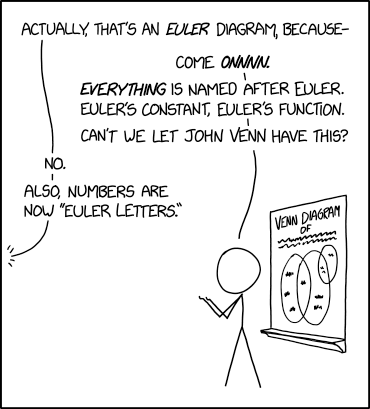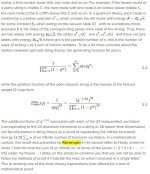Consider the expression:
(1) s = 1 -1 +1 -1......
This can be divided into two forms, one that sums to 0 and the other that sums to 1 depending on weather the number of terms is even or odd. This can be enumerated by two separate functions, s0, with an odd number of terms and s2, with an even number of terms.
We know that
(2) s0 + s2 = 1 since s0 = 1 and s2 = 0.
The expression (1) is undetermined and can be either s0 or s2.
We have that
(3) s = 1 -1 + 1 -1... = 1 -(1 -1 + 1 -1 ...) = 1 -s'
Where s' = 1 - 1 + 1 - 1... and is not the same as s but rather the complimentary in that it is, s, offset by one. It would a mistake to set ,s', equal to ,s, since both are undetermined. On rearranging (3), we have:
(4) s + s' = 1
Which is similar to (2) with the added difference that (4) does not specify which is s0 and which is s2 but rather that if one is the odd function then the other is the even function.
Of course
This is in response to those who want to assign the value of 1/2 to the series via:
(5) s = 1 -1 +1 -1...
(6) s = 1 -(1 -1 +1...) = 1 -s
=> s = 1/2
This can not be done since the s on the left side of (6) is not the same as the one on the right since they are both separately indeterminate. And in fact, one is the complement of the other.
Also
1/(1-S) = 1 + S + S^2 + S^3 + . . . For |S| < 1
Does not apply for S = -1 Where 1/[1 -(-1)] = 1/2 = 1 - 1 + 1 -1 . . . since |S| must be less than 1.
The result is that the series is never 1/2 but is rather is 1 when ending on an odd number and 0 when ending on an even number of terms - it is therefore divergent.
Another way of seeing this is by taking (4) and dividing by 2 or:
(s+s')/2 = 1/2 - This claiming that the value of 1/2 is not, s, but rather the average of s and s'. That is, what many have been claiming is the value of the series (i.e 1/2) is actually the average of the two separate series.
This leads to the inclination that the sum of all positive natural numbers is equal to -1/12 is not sound when it is derived using the following argument:
s1 = 1 - 1 + 1 - 1 + . . . = 1/2 - already assumed invalid by the above argument
s2 = 1 - 2 +3 - 4 + 5 - 6 + . . .
2*s2 = 1 - 2 + 3 - 4 + 5 - 6 + . . .
+ 1 - 2 + 3 - 4 + 5 + . . .
= 1 - 1 + 1 - 1 + 1 . . . = 1/2 - again invalid
=> s2 = 1/4 - which is also strange for a sum of integers.
s = 1 + 2 + 3 + 4 + 5 + . . . - start with the sum of all integers
s - s2 = 1 + 2 + 3 + 4 + 5 + . . .
-(1 - 2 + 3 - 4 - 5 + . . .) = s - 1/4 - substract s2 or 1/4 from both sides
= 0 + 4 + 0 + 8 + 0 + 12 + . . .
= 4 * ( 1 + 2 + 3 + 4 + 5 + . . . ) = 4 * s = s - 1/4 => s = -1/12
or rather that
1 + 2 + 3 + 4... = -1/12 This is stating that the sum of all positive integers is -1/12.
Conclusion:
This result that the sum of all positive numbers is -1/12 is not logically valid when demonstrated as in this derivation since the initial premise that s1 = 1/2 is not valid.
(1) s = 1 -1 +1 -1......
This can be divided into two forms, one that sums to 0 and the other that sums to 1 depending on weather the number of terms is even or odd. This can be enumerated by two separate functions, s0, with an odd number of terms and s2, with an even number of terms.
We know that
(2) s0 + s2 = 1 since s0 = 1 and s2 = 0.
The expression (1) is undetermined and can be either s0 or s2.
We have that
(3) s = 1 -1 + 1 -1... = 1 -(1 -1 + 1 -1 ...) = 1 -s'
Where s' = 1 - 1 + 1 - 1... and is not the same as s but rather the complimentary in that it is, s, offset by one. It would a mistake to set ,s', equal to ,s, since both are undetermined. On rearranging (3), we have:
(4) s + s' = 1
Which is similar to (2) with the added difference that (4) does not specify which is s0 and which is s2 but rather that if one is the odd function then the other is the even function.
Of course
This is in response to those who want to assign the value of 1/2 to the series via:
(5) s = 1 -1 +1 -1...
(6) s = 1 -(1 -1 +1...) = 1 -s
=> s = 1/2
This can not be done since the s on the left side of (6) is not the same as the one on the right since they are both separately indeterminate. And in fact, one is the complement of the other.
Also
1/(1-S) = 1 + S + S^2 + S^3 + . . . For |S| < 1
Does not apply for S = -1 Where 1/[1 -(-1)] = 1/2 = 1 - 1 + 1 -1 . . . since |S| must be less than 1.
The result is that the series is never 1/2 but is rather is 1 when ending on an odd number and 0 when ending on an even number of terms - it is therefore divergent.
Another way of seeing this is by taking (4) and dividing by 2 or:
(s+s')/2 = 1/2 - This claiming that the value of 1/2 is not, s, but rather the average of s and s'. That is, what many have been claiming is the value of the series (i.e 1/2) is actually the average of the two separate series.
This leads to the inclination that the sum of all positive natural numbers is equal to -1/12 is not sound when it is derived using the following argument:
s1 = 1 - 1 + 1 - 1 + . . . = 1/2 - already assumed invalid by the above argument
s2 = 1 - 2 +3 - 4 + 5 - 6 + . . .
2*s2 = 1 - 2 + 3 - 4 + 5 - 6 + . . .
+ 1 - 2 + 3 - 4 + 5 + . . .
= 1 - 1 + 1 - 1 + 1 . . . = 1/2 - again invalid
=> s2 = 1/4 - which is also strange for a sum of integers.
s = 1 + 2 + 3 + 4 + 5 + . . . - start with the sum of all integers
s - s2 = 1 + 2 + 3 + 4 + 5 + . . .
-(1 - 2 + 3 - 4 - 5 + . . .) = s - 1/4 - substract s2 or 1/4 from both sides
= 0 + 4 + 0 + 8 + 0 + 12 + . . .
= 4 * ( 1 + 2 + 3 + 4 + 5 + . . . ) = 4 * s = s - 1/4 => s = -1/12
or rather that
1 + 2 + 3 + 4... = -1/12 This is stating that the sum of all positive integers is -1/12.
Conclusion:
This result that the sum of all positive numbers is -1/12 is not logically valid when demonstrated as in this derivation since the initial premise that s1 = 1/2 is not valid.



